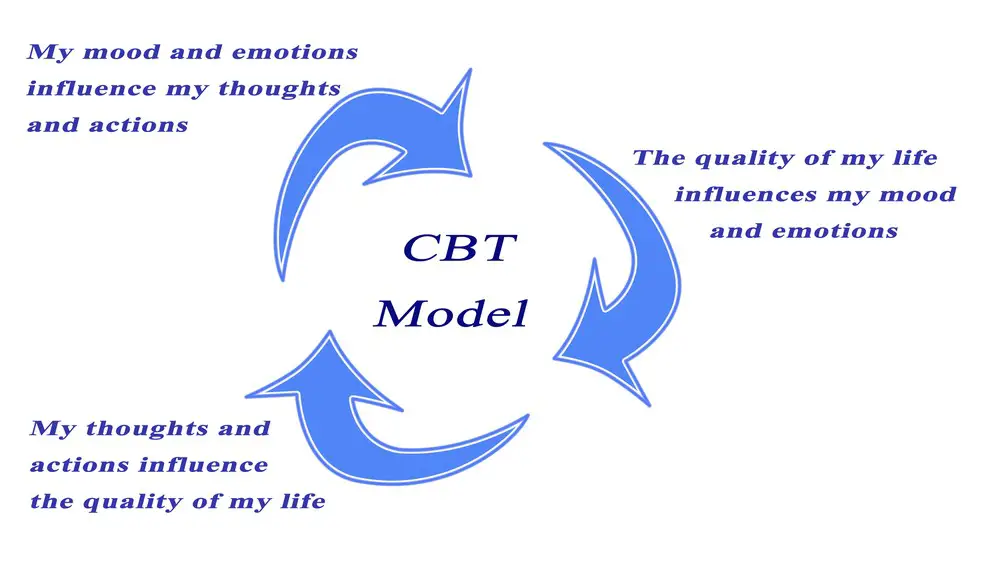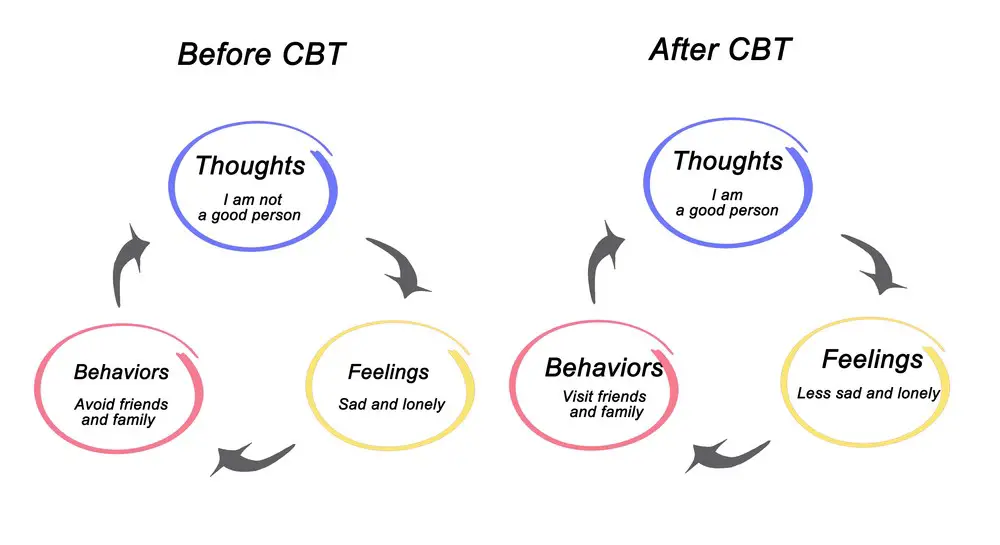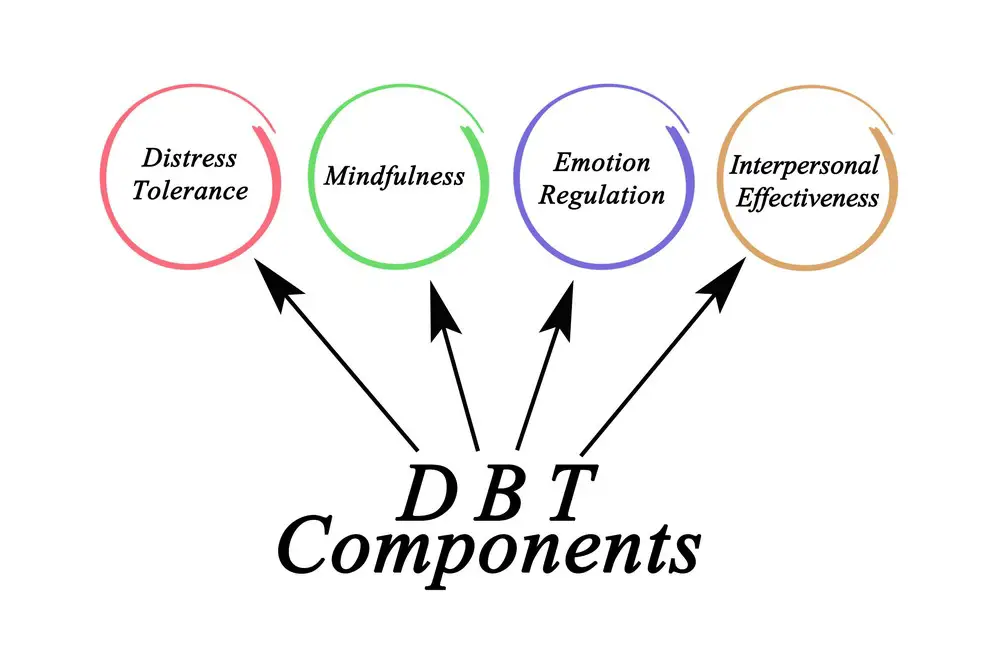As a BetterHelp affiliate, we receive compensation from BetterHelp if you purchase products or services through the links provided
People often misunderstand therapy due to some entirely misplaced social stigma around the practice.
Thankfully, in today’s world, therapy is becoming a more widely recognized outlet for handling stress and mental illness. Still, whether you’re looking for therapy yourself or seeking to learn more about the world of psychology, you might be wondering how DBT and CBT compare.
Dialectical Behavior Therapy (DBT) is a holistic worldview that looks at the interconnectedness of events to help patients see the world in a new way.
Cognitive Behavioral Therapy (CBT), on the other hand, is designed to help people overcome emotional trauma by addressing and changing their thoughts or beliefs about the situation.
Both methods are under the general umbrella of talk therapy, and there are arguments as to the effective treatment techniques used by both in extreme behaviors, substance use disorders, self-destructive behaviors, and negative thoughts.
This article will discuss the differences between cognitive behavioral treatment and dialectical behavior therapy.
What Is Cognitive Behavior Therapy?
A short-term behavioral treatment, CBT addresses mental health issues and draws connections among beliefs, feelings, thoughts, and the subsequent actions driven by those thought patterns.
People who go through CBT begin to recognize how their perceptions of events directly influence their reaction to specific events, whether triggered by a particular topic or behavior patterns.
CBT focuses on connections and includes an umbrella of therapy methods: rational emotive behavior therapy, cognitive therapy, and dialectical behavior therapy (but more on this later). Based on the symptoms a person is experiencing, a mental health professional will recommend or lean towards a different holistic approach to talk therapy.
For example, someone with a generalized or similar anxiety disorder will have a different course of treatment than someone experiencing negative thoughts and engaging in harmful behaviors. A mental health clinician usually aims for weekly therapy sessions, but group therapy is also an effective treatment for some conditions.

How Does CBT Work?
CBT’s primary goal is not to simply change negative thoughts into positive ones; instead, it is to teach the individual to recognize how their reaction to events or thoughts changes their behavior.
A person with anxiety, for example, might ruminate on the negative, believing that everything they do will fail, leading to a negative emotional response and ‘numbing’ the person’s response to anything good that happens.
These negative thoughts become reinforced as the person perceives more and more of the negative around them, solidifying the behavior. Then, those behaviors inevitably influence the person’s thought process, creating more of a vicious cycle.
CBT teaches them to practice skills that change their thought patterns and escape the cycle of anxiety. At its heart, CBT treatment methods operate on the simple belief that we can challenge our thoughts, thereby regulating them.
Doing so is called cognitive restructuring, and the concept of changing crystallized thinking patterns is credited to psychiatrist Aaron T. Beck. He saw the link between cognitive errors in judgment and depressive thoughts or dysfunctional beliefs.
Therapy sessions focus on redirecting those intense emotions throughout the therapeutic process. CBT treats emotional responses as its focal point, teaching patients mindfulness skills to recognize those negative emotions when they arise.

CBT also often involves sessions emphasizing emotion regulation and coping skills, which can help correct problematic patterns in thought.
Of course, for many people, these new skills are not easy; it’s an active, challenging process that requires a lot of focus and effort. After all, fighting off stress isn’t easy for anyone, much less a person with mental health challenges. During individual therapy, therapists are on the lookout for common cognitive errors. These usually take the following forms:
- Self-absorption
- Abstraction
- Overgeneralizing
- Dichotomous thinking
- Self-blame
Self-Absorption
Self-absorption doesn’t suggest that a person is selfish, but rather that the person incorrectly believes that people are constantly attentive to their failures. A common self-reference would be, “People always focus on everything I do wrong.”
Abstraction
Another standard cognitive error is a selective abstraction, in which the affected person dismisses their accomplishments or goals in light of their shortcomings. An abstractive cognitive error might look like this: “I am and will always be a failure, no matter what I do.”
Overgeneralizing
Overgeneralizing is very easy for anyone stressed out about the future, even more so for those with mental health challenges. For someone with eating disorders, for example, a typical example of an overgeneralized cognitive error might be as follows: “I couldn’t stop myself from binging this time, so I’ll never be able to fix myself.”
During CBT treatment, a therapist will address the fallacious thinking that drives these thought patterns to improve interpersonal relationships and increase self-acceptance.
Dichotomous Thinking
Seeing the world in black and white is another standard cognitive error that therapists will address during individual therapy. Patients who doubt their interpersonal effectiveness may believe that the whole world is against them or that nothing they do matters, which are dichotomous thought patterns that can inform their behavior.
CBT therapy helps individuals recognize these thought patterns to regulate their thoughts more effectively, recognize dichotomous thinking, and avoid making behavioral choices based on those negative thoughts.

Common CBT Exercises
In addition to learning to recognize these and other fallacious thought patterns, therapy patients are encouraged to complete homework designed to challenge their beliefs with thought exercises and teach them to exercise mindfulness and use relaxation techniques.
Journaling is also a common suggestion by therapists for CBT treatment. It helps the person keep a log of their struggles and successes to see their progress in overcoming those thought patterns.
Group therapy can also be helpful depending on the patient’s condition. Seeing others with the same struggles encourages the individual that they’re not alone and that others are walking the same road.
What Does CBT Treat?
CBT was initially designed for treating depression, but it has since become a much more widely used method for a variety of mental health disorders, including eating disorders, anxiety disorders, substance abuse problems, obsessive-compulsive disorder, phobias, mood disorders, bipolar disorder, chronic suicidal ideation, and a wide range of other conditions.
Cognitive behavioral therapy has merit in all of these conditions. It gives affected individuals a more holistic way of looking at their thoughts and beliefs, teaching them distress tolerance and more effective regulation of intense emotions. The value of CBT, whether in individual or group sessions, cannot be overstated.

What Is Dialectical Behavioral Therapy
Dialectical behavioral therapy (DBT) teaches people how to live in the moment, manage stressful situations, and effectively cope with stress. If those goals sound similar to CBT, DBT is an alternate treatment to CBT and is classed in the same subgroup of therapeutical disciplines.
Originally used to treat borderline personality disorder and other personality disorders, DBT has also found merit in treating other mental health conditions by helping people regulate their emotions or who are exhibiting self-destructive behavior.
It is also sometimes effective in treating posttraumatic stress disorder (PTSD). Oftentimes, DBT and CBT will have similar treatment plans, including the following:
- Group sessions
- Individual therapy
- Phone coaching
Group Sessions
In both CBT and DBT, patients benefit from spending time in a group setting to get reinforcement from their peers. Group members share the challenges associated with their disorder or condition and can provide positive feedback when members share their successes.
During these group engagements, therapists will focus on developing individual therapeutic relationships and teaching mindfulness to help cope with difficulties.
Individual Therapy
Oftentimes, some privacy is required. Patients will learn essential behavioral skills and adapt them to the challenges in their personal life.
Phone Coaching
One of the most significant benefits of developing a therapeutic relationship is that the therapist is on call often whenever the patient is experiencing complex thoughts or emotions.
Patients are encouraged to call the therapist whenever they are experiencing a difficult time or having trouble regulating their emotions.
After all, it’s one thing to learn to be mindful of your emotional thought processes but another thing to implement. Phone coaching can help patients recenter on the exercises they’ve learned to get more effective treatment.
How Does DBT Work?
DBT focuses on mindfulness, aiming to help patients live in the moment and recognize the challenges of their mental health condition.
This might seem cliche and arbitrary on first inspection, but the capability to pay attention to what’s inside you is extremely useful. It helps patients slow down and use healthy coping skills during emotional turbulence.
DBT treatment is often broken down into four stages designed to help the patient experience happiness, build relationships, and pursue life goals.
More often than not, most dialectical behavioral therapy sessions are done via group therapy, where each individual can validate their experiences and the experiences of others. Some individual sessions help consolidate what was learned in the group sessions.
Stage 1
At the start of treatment, a therapist will first address the most concerning or serious behavior. Self-destructive behaviors, such as self-harm or suicidal thoughts, are addressed and confronted using DBT techniques.
Stage 2
After addressing any pressing concerns for the patient’s wellbeing, a therapist will move on to other factors influencing a person’s quality of life, including how well they communicate with others, their capacity for regulating emotions, and their ability to tolerate distress.
Stage 3
Once a patient learns how to regulate their emotions more effectively and tolerate stressful situations and thoughts, the therapist will shift to developing self-esteem and relationships.
These are important to developing healthy relationships and help refine the emotional regulation skills the patient has learned through therapy.
Stage 4
By stage 4, the patient has gotten a good grasp on being mindful, developing relationships, and improving their self-esteem.
During stage 4, therapists transition to a sendoff phase where they help the patient discover how to get the most out of their lives, whether it be finding activities that bring them happiness, building relationships with their family and friends, or pursuing significant life goals.
During this last phase, patients learn that despite the challenges they face in life, they are capable of overcoming them and still experience happiness.
What Skills Does DBT Teach
DBT treatment options include many techniques, and during dialectical behavioral therapy, patients will learn various skills.
Mindfulness
Disciplined mindfulness can help patients stay calm and avoid automatic behaviors and impulsive patterns that continue the cycle of negative thoughts.
Mindfulness exercises are often physiological, too. It’s a way of hitting the reset button if you will. A DBT therapist will teach patients how to breathe in deeply and pay attention to the rising and falling of their stomachs.
Focusing on taking proper deep breaths can reset the automatic negative process that would typically run rampant in a person’s mind and help them regulate those emotions.
Distress Tolerance
Distress tolerance is another technique used more in DBT vs CBT. This technique relies on distracting the person, improving the stressful moment, and self-soothing behaviors.
For example, a therapist might suggest that someone experiencing emotional distress take a quick run around the block to mitigate the effect of emotional distress.
Learning how to manage those problematic thoughts and emotions is a step on the road to recovery and can help patients tolerate distressing thoughts or emotions.
Building Interpersonal Effectiveness
This discipline teaches the patient to become more aware of their own needs and desires, learning how to say ‘no’ in a relationship respectfully and healthily.
Oftentimes, patients undergoing DBT treatment have strong emotions that make it challenging to communicate healthily with their family, significant other, or coworkers.
Learning how to speak your mind clearly, dealing with challenging people, and respecting yourself go a long way in avoiding fatalistic thinking and developing self-respect.
Very Well Mind offers the acronym GIVE as a sample exercise for this treatment goal. Patients are expected to be gentle, show interest, validate the other person’s feelings, and have an easy attitude.
Learning how to not only communicate freely without fear of judgment but also listen and demonstrate an interest in the other person’s opinion goes a long way to developing interpersonal relationships.
What Is DBT Used to Treat?
DBT is an effective treatment for various disorders and conditions affecting the mind. As with CBT, DBT is not necessarily a cure-all for these conditions; it’s a healthy part of a DBT treatment plan.
Mental health professionals might assign medication along with DBT or CBT therapy to help a person cope with their life challenges. With that being said, DBT therapy has shown positive results when used to treat the following conditions and disorders:
- Attention deficit/hyperactivity disorder
- Borderline personality disorder
- Bipolar disorder
- Eating disorders
- Major depressive disorder
- Generalized anxiety disorder
- Non-suicidal self-injury
- Obsessive-compulsive disorder
- Suicidal behavior
- Substance use disorder
- Post-traumatic stress disorder
In many of these disorders, there is an aspect of cognition that leads the affected person to ruminate and cycle through negative emotions leading to self-destructive behaviors. DBT therapy, which treats emotional response, can help with some or all aspects of these disorders.
How Are CBT and DBT Different?
CBT and DBT are forms of talk therapy in which you speak with a mental health professional to help you navigate the challenges in your life, eventually by yourself.
Cognitive behavioral therapy teaches patients how their thoughts, feelings, and actions are connected.
Changing those initial thoughts, or at least learning to regulate their intensity, can change their whole perspective. Negative thoughts and faulty interpretations of events can lead to further negative emotions and impact behavior. CBT treatment targets problematic behaviors and has shown merit in treating several types of disorders.
DBT, while a subdiscipline of CBT and a similar form of therapy, has a few key differences. First, DBT focuses much more on the role of mindfulness and self-acceptance during the therapeutic process. CBT may teach you how to regulate emotions and recognize faulty thinking, but it doesn’t give you any tools, per se, to live a better life.
DBT therapy, on the other hand, provides actionable steps to reach the primary goal of DBT: restoring emotional balance after a traumatic event.
Originally used to treat borderline personality disorder, DBT has since become a haven for people who have been in abusive relationships or experienced sexual trauma, and for a good reason: DBT validates those unpleasant emotions and helps the patient change the unhealthy behaviors perpetuated by the pain of those emotions or losses.
Core Philosophy of DBT vs CBT
One of the main differences between CBT and DBT is that cognitive behavioral therapy believes that the interpretation of an event is much more significant than the trauma itself.
CBT is much more stoic in its approach to recovery, believing that if the patient can learn to regulate the responsive emotions causing self-destructive behavior, they can challenge irrational interpretations and essentially counsel themselves.
DBT’s core philosophy, on the other hand, validates and accepts the unpleasant emotions and feeling associated with the traumatic event or disorder-related thoughts.
DBT aims to help patients identify irrational negative thoughts, much like CBT. Still, it also emphasizes mindfulness and self-acceptance, believing that it’s not enough for a person to know how to correct irrational thoughts simply.
No, a person must be mindful of themselves and accepting of themselves and others, and have a purpose in life to strive towards.
Methods and Techniques
CBT and DBT draw connections between thoughts, emotions, and behavior to help patients realize how their irrational interpretations can negatively impact their mood, behavior, and subsequent actions.
The main difference between the two is that CBT attributes all negative attributes of the target disorder as being distinctly connected to the patient’s thoughts, emotions, and behaviors.
For example, if a patient has an intense fear of failure, a CBT therapist might ask questions such as, “What makes you think you can’t succeed?” and “What can you do to succeed?”
In DBT, however, a more holistic, mindful approach to the same problem would be presented. DBT emphasizes learning to recognize and validate those negative emotions, as difficult as that may be, and accept them at face value.
Yes, the thought process behind those negative emotions will be challenged, but a DBT therapist will emphasize mindfulness and self-acceptance to bring about change.

Online Therapy and a Good Night’s Rest
If you’re struggling with heavy thoughts and emotions, or if your relationships are suffering due to negative behavior patterns, both CBT and DBT therapies are available online. They are effective in treating a range of disorders.
There’s no shame in asking for help when developing mindfulness, challenging negative thoughts, and learning to accept and validate traumatic experiences. Online therapy is much cheaper and just as effective as in-person therapy. With many businesses, your therapist is available anytime to talk if you’re having a rough time.
When it comes to stress management, there are lots of practical resources to help you manage, but one of the most significant factors that can positively impact your mood is a good night’s rest. Research suggests that people who sleep better generally have a better mood, a healthier outlook on life, and improved energy throughout the day.
Whether you need to readjust your nighttime routine to build a healthier sleep schedule or take a gentle sleep aid, getting a proper night’s rest can help you feel better about the day ahead when you wake up in the morning. If you or a loved one is struggling with negative emotions or burdensome thoughts, consider online therapy as an option.
- 3 Ways Wearing a Hat Can Help Lower Your Stress Levels - April 19, 2025
- Breaking the Silence: Why Men’s Mental Health Matters More Than Ever - April 15, 2025
- How to Transform a Home’s Patio Space into a Relaxing Space - March 23, 2025
This site contains affiliate links to products. We will receive a commission for purchases made through these links.



